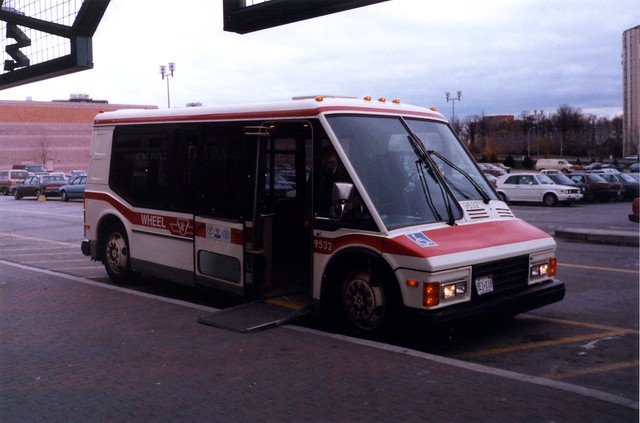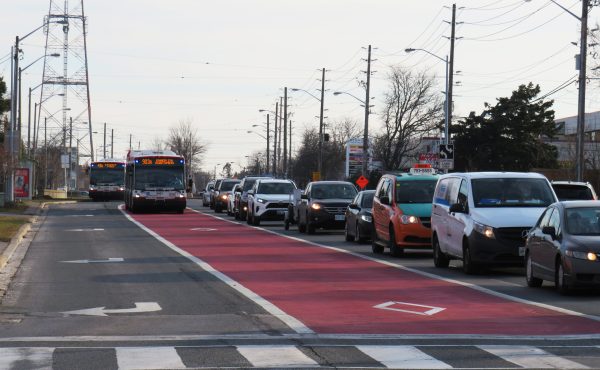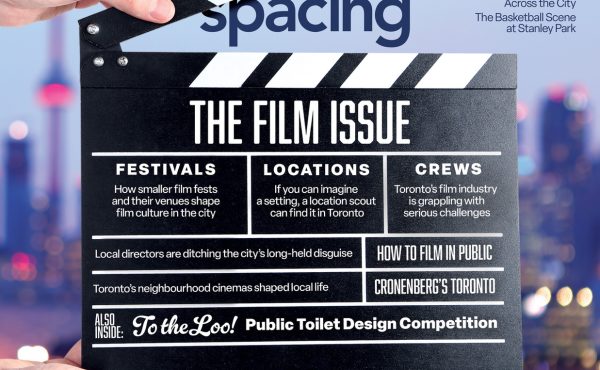Editor’s note: This is an augmented version of a piece that appeared in Spacing’s Summer 2012 issue.
In January, I suffered a serious cycling injury while commuting to work. To put a long story short, a motorist cut into my path while I was making a left turn, and I veered into the streetcar tracks. The resulting fall shattered my kneecap; the injury restricted my mobility for a period of three months. As I was living on my own in a second-floor apartment in the Brockton neighbourhood, I had to temporarily move in with family in North York.
My temporary disability gave me a first-hand experience how Wheel-Trans, the paratransit division of the Toronto Transit Commission, operates, and some of the challenges of navigating the transit system in a wheelchair and on crutches.
The TTC is becoming increasingly accessible to all users. With the retirement of the remaining GM “New Look” buses last fall, the bus fleet is now 100 percent accessible, and thirty of the TTC’s 69 subway stations are now equipped with elevators. But despite these efforts in improving accessibility, Wheel- Trans is, and will continue to be, an essential part of the transit network. The current streetcar fleet is inaccessible to passengers in wheelchairs and can difficult to board. New, fully accessible streetcars will begin to replace the older CLRVs starting in 2014; the subway will not be fully accessible until 2025. And there will still be customers who live too far from a bus stop or need extra assistance that the regular system can not provide.
While I was long aware and supportive of the need for complete transit accessibility, I had not fully understood the importance of providing it until my injury. My office is right in front of a downtown subway station, but the lack of elevators precludes the use of the conventional system. Toronto Western Hospital, where I was treated and continue to visit for follow-ups, is at the junction of two streetcar lines but has no accessible service.
Started in 1975, Wheel-Trans provides nearly 2.7 million trips to over 65,000 registered users (2010 statistics). Approximately 65 percent of the trips are provided by TTC employees using Wheel-Trans minibuses, while the remainder are contracted to taxi companies using modified mini-vans or regular sedan taxicabs. Unlike salaried TTC operators, contracted taxi drivers are paid $2 per half kilometre when the vehicle is occupied, regardless of how many people are in the cab.
Eligibility for Wheel-Trans is determined primarily through a short, 15 minute interview with a Wheel- Trans representative. Ironically, most interviews are held at Metro Hall, which is distant from accessible transit, and so a ride has to be arranged to attend. The TTC headquarters at Davisville Station (which is accessible) or even City Hall would be far more logical locations to hold the interviews. After ten days, a package arrives with a registration card and instructions on how to use the service. Trips are booked by phone or online. Pre-arranged regular travel, such as regular medical appointments or commutes to and from work is arranged in advance, but all other irregular trips have to be booked the day before.
Wheel-Trans is a very expensive system to operate. It has a 6.1% fare-recovery ratio versus 71.3% for the regular transit system. The cost to operate the system is on average over $30 per ride.
While I found Wheel-Trans – both TTC-operated and the taxi-contracted services – to be generally reliable and efficient for my needs, I would have preferred to make full use of the conventional system because it has the flexibility that paratransit simply can not provide.
For all other casual trips, I have been using the conventional transit system, partly because it is more convenient to use, and so I could come and go when I wanted. In this respect, I was lucky. My family’s apartment, at the junction of two busy bus routes and close to two elevator-equipped stations, made using the regular transit system possible.
The modern, low floor buses have some disadvantages to older, high-floor models, specifically that they have lower seated and standing capacity because of their design. But they are much easier to board, and using a wheelchair was easy. One also learns to appreciate the kneeling feature while using crutches.
Some subway stations are easier to navigate in a wheelchair than others. The apartment I am staying at for now is between two accessible subway stations, Downsview and Sheppard-Yonge. Downsview, opened in 1996, has a single elevator that serves the bus terminal, the mezzanine and the subway platforms and is very easy to navigate. Sheppard-Yonge is much more difficult. Built in 1973 and retrofitted to accommodate the Sheppard Subway that opened in 2002, three different elevators are required to pass from the bus terminal to the Yonge Subway. A fourth elevator is needed if going between Sheppard West bus and the eastbound Sheppard Subway.
It really has been interesting seeing how the other side of the transit system works, and the challenges of using the regular system. Disability requires both patience and creativity. Thankfully, I found all TTC employees really friendly and helpful, without being patronizing. As of May, I have returned to some of my normal activities, including cycling, and moved back on my own. But passengers with permanent disabilities or chronic illness require the use of Wheel-Trans. They must not be overlooked when the TTC progresses to becoming fully wheel-chair accessible.
Photo by Stephen Rees





2 comments
i feel your pain! when i worked downtown (near osgoode station) our intern relied on wheel-trans to come to the office from her home in north york. her hours varied, depending on wheel-trans was available – officially she was supposed to be at work from 10 to 3, but some days the only pickup time available to her was at 7 o’clock, so she’d be waiting at the door when i arrived at 8:30.
when i broke my foot last year (tripped on a crooked city of toronto sidewalk) i just gave up on the ttc and drove every day. i’m just glad it was my left foot that was out of commission, not the right.
the thing about improving accessibility though is that it helps everyone. is you’ve ever pushed a stroller, or carried something heavy or awkward home by ttc, you can appreciate the benefits of accessible transit.
Another problem with elevators is that they are not necessarily placed in a similar location in the various stations. The accessible subway station near me has its elevators at the west end, but others down the line are at the east end. Even with a walker, some days that walk across the station is just too much for me.
And if an elevator is out of service for some reason, the alternate routes can be ridiculous. Go ahead, try them when you have time. It isn’t as though I might need to be somewhere by a certain time; I have loads of extra time on my hands!
I hate driving, but sometimes it really is the better way.